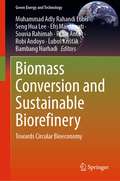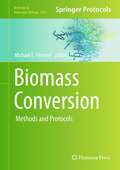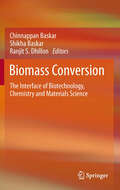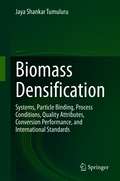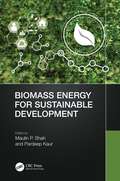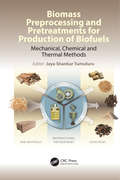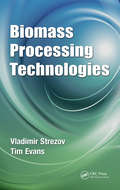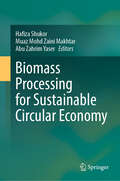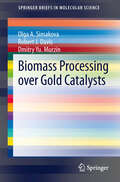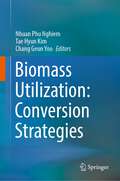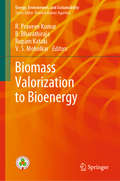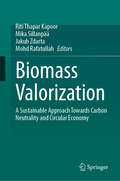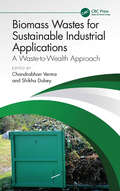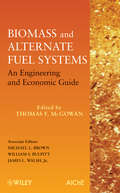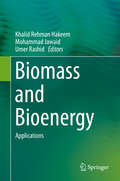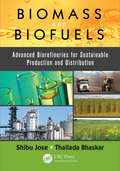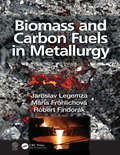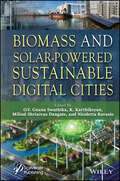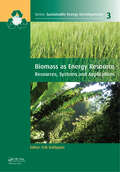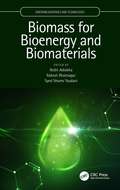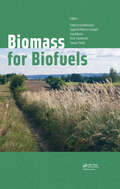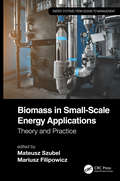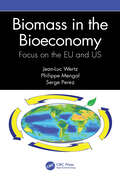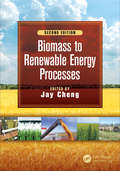- Table View
- List View
Biomass Conversion and Sustainable Biorefinery: Towards Circular Bioeconomy (Green Energy and Technology)
by Seng Hua Lee Petar Antov Ľuboš Krišťák Muhammad Adly Rahandi Lubis Efri Mardawati Souvia Rahimah Robi Andoyo Bambang NurhadiThis book highlights recent progress on the advancements toward optimization of major biorefinery processes, including biomass pretreatment and fractionation, saccharification of sugars, and conversion of sugars and lignin into fuels and chemical precursors. The continual improvement of these processes and their integration in the format of a modern biorefinery is paving the way for a sustainable bio-economy that will displace large portions of petroleum-derived fuels and chemicals with renewable substitutes. Written by leading researchers from academia and well-renowned industry professionals, this book provides a comprehensive review of various aspects related to the recent developments in biomass conversion and biorefinery, aimed at successfully implementing the circular economy principles in various industries.
Biomass Conversion: Methods and Protocols (Methods in Molecular Biology #908)
by Michael E. HimmelBiomass conversion research is a combination of basic science, applied science, and engineering testing and analysis. Conversion science includes the initial treatment (called pre-treatment) of the feedstock to render it more amenable to enzyme action, enzymatic saccharification, and finally product formation by microbiological or chemical processes. In Biomass Conversion: Methods and Protocols, expert researchers in the field detail methods which are now commonly used to study biomass conversion. These methods include Biomass Feedstocks and Cellulose, Plant Cell Wall Degrading Enzymes and Microorganisms, and Lignins and Hemicelluloses. Written in the highly successful Methods in Molecular BiologyTM series format, the chapters include the kind of detailed description and implementation advice that is crucial for getting informed, reproducible results in the laboratory.
Biomass Conversion: The Interface of Biotechnology, Chemistry and Materials Science
by Ranjit S. Dhillon Shikha Baskar Chinnappan BaskarThe consumption of petroleum has surged during the 20th century, at least partially because of the rise of the automobile industry. Today, fossil fuels such as coal, oil, and natural gas provide more than three quarters of the world's energy. Unfortunately, the growing demand for fossil fuel resources comes at a time of diminishing reserves of these nonrenewable resources. The worldwide reserves of oil are sufficient to supply energy and chemicals for only about another 40 years, causing widening concerns about rising oil prices. The use of biomass to produce energy is only one form of renewable energy that can be utilized to reduce the impact of energy production and use on the global environment. Biomass can be converted into three main products such as energy, biofuels and fine chemicals using a number of different processes. Today, it is a great challenge for researchers to find new environmentally benign methodology for biomass conversion, which are industrially profitable as well. This book focuses on the conversion of biomass to biofuels, bioenergy and fine chemicals with the interface of biotechnology, microbiology, chemistry and materials science. An international scientific authorship summarizes the state-of-the-art of the current research and gives an outlook on future developments.
Biomass Densification: Systems, Particle Binding, Process Conditions, Quality Attributes, Conversion Performance, and International Standards
by Jaya Shankar TumuluruThis monograph discusses the various biomass feedstocks currently available for biofuels production, and mechanical preprocessing technologies to reduce the feedstock variability for biofuels applications. Variability in the properties of biomass—in terms of moisture, particle size distribution, and low-density—results in storage, transportation, handling, and feeding issues. Currently, biorefineries face serious particle bridging issues, uneven discharge, jamming of equipment, and transportation problems. These issues must be solved in order for smooth operations to be possible. Mechanical preprocessing technologies, such as size reduction, densification, and moisture management using drying and dewatering, can help to overcome these issues. Many densification systems exist that will assist in converting low-density biomass to a high-density commodity type feedstock. In 6 chapters, the impact of densification process variables, such as temperature, pressure, moisture, etc., on biomass particle agglomeration, the quality of the densified products, and the overall energy consumption of the process are discussed, as are the various compression models for powders that can be used for biomass particles agglomeration behavior and optimization of the densification process using statistical and evolutionary methods. The suitability of these densified products for biochemical and thermochemical conversion pathways is also discussed, as well as the various international standards (CEN and ISO) they must adhere to. The author has worked on biomass preprocessing at Idaho National Laboratory for the last ten years. He is the principal investigator for the U.S. Department of Energy Bioenergy Technologies Office-funded “Biomass Size Reduction and Densification” project. He has developed preprocessing technologies to reduce cost and improve quality. The author has published many papers and books focused on biomass preprocessing and pretreatments. Biomass process engineers and biorefinery managers can benefit from this book. Students in chemical, mechanical, biological, and environmental engineering can also use the book to understand preprocessing technologies, which greatly assist in improving the biomass critical material attributes. The book can help policymakers and energy systems planners to understand the biomass properties limitations and technologies to overcome the same.
Biomass Energy for Sustainable Development
by Maulin P. Shah Pardeep KaurThe potential future fluctuations in energy security and potential climate change impacts require an emphasis on clean and renewable energies to safeguard the environment as well as economic livelihoods. The current recalcitrant nature of biomass processing has led researchers to find the most suitable technique for its depolymerization, as well as various strategies to pretreat the biomass which include physical, thermochemical, and biochemical methods and a combination of these. Biomass Energy for Sustainable Development examines how optimal biomass utilization can reduce forest management costs, help mitigate climate change, reduce risks to life and property, and help provide a secure, competitive energy source into the future.Features: Provides a comprehensive review of biomass energy and focuses on in-depth understanding of various strategies to pretreat biomass including physical, chemical, and biological Explores multidisciplinary, novel approaches including AI for furthering the understanding and generation of models, theories, and processes in the field of bioenergy Covers the sustainable development goals for bioenergy, including the related concepts of bioeconomy and the potential environmental impact from reliance on bioenergy
Biomass Preprocessing and Pretreatments for Production of Biofuels: Mechanical, Chemical and Thermal Methods
by Jaya Shankar TumuluruEngineering the physical, chemical, and energy properties of lignocellulosic biomass is important to produce high-quality consistent feedstocks with reduced variability for biofuels production. The emphasis of this book will be the beneficial impacts that mechanical, chemical, and thermal preprocessing methods can have on lignocellulosic biomass quality attributes or specifications for solid and liquid biofuels and biopower production technologies. "Preprocessing" refers to treatments that can occur at a distance from conversion and result in an intermediate with added value, with improved conversion performance and efficiency. This book explores the effects of mechanical, chemical, and thermal preprocessing methods on lignocellulosic biomass physical properties and chemical composition and their suitability for biofuels production. For example, biomass mechanical preprocessing methods like size reduction (which impacts the particle size and distribution) and densification (density and size and shape) are important for feedstocks to meet the quality requirements for both biochemical and thermochemical conversion methods like enzymatic conversion, gasification, and pyrolysis process. Thermal preprocessing methods like drying, deep drying, torrefaction, steam explosion, hydrothermal carbonization, and hydrothermal liquefaction effect feedstock's proximate, ultimate and energy property, making biomass suitable for both solid and liquid fuel production. Chemical preprocessing which includes washing, leaching, acid, alkali, and ammonia fiber explosion that can enable biochemical composition, such as modification of lignin and hemicellulose, and impacts the enzymatic conversion application for liquid fuels production. This book also explores the integration of these preprocessing technologies to achieve desired lignocellulosic biomass quality attributes for biofuels production.
Biomass Processing Technologies
by Ian MuehlenhausThis book is a thoroughly up-to-date treatment of all the available technologies for biomass conversion. Each chapter looks at the viability and implementation of each technology with examples of existing equipment and plants. In addition, the text addresses the economics of biomass processing. The book could also be used as a supplementary text for senior undergraduate courses on biomass processing.
Biomass Processing for Sustainable Circular Economy
by Abu Zahrim Yaser Hafiza Shukor Muaz Mohd Zaini MakhtarThis book explores the pivotal role of biomass processing in catalyzing a sustainable circular economy, highlighting its ability to convert waste into useful materials. It offers a wide spectrum of topics, from Malaysia's biomass use to bioenergy supply chains and cutting-edge extraction technologies for bioactive compounds. Key bioconversion strategies like enzyme and single-cell protein production via biorefineries and green biosynthesis of solvents and chemicals are explored in detail. The book describes innovative low-cost biomimetic technologies using Black Soldier Fly and Compost Worms, bioelectrochemical systems fueled by biomass, and the use of biomass in food technology. The book further describes activated carbon production from wastewater treatment, hydrocarbons in high liquids using co-pyrolysis, and vegetable oils as renewable raw materials for polyurethane biobased foam. The primary themes include sustainability, engineering, and economic sustainability, with explorations of the latest trends and innovations in the processing of biomass. The use of biomass in circular economy principles, its transformation into renewable sources of energy, and its incorporation in various sectors are also explained. Through new technologies and eco-friendly strategies, this book is a necessity for researchers, business professionals, and policymakers committed to the innovation of biomass-based solutions.
Biomass Processing over Gold Catalysts (SpringerBriefs in Molecular Science)
by Robert J. Davis Olga A. Simakova Dmitry Yu MurzinThe book describes the valorization of biomass-derived compounds over gold catalysts. Since biomass is a rich renewable feedstock for diverse platform molecules, including those currently derived from petroleum, the interest in various transformation routes has become intense. Catalytic conversion of biomass is one of the main approaches to improving the economic viability of biorefineries. In addition, Gold catalysts were found to have outstanding activity and selectivity in many key reactions. This book collects information about transformations of the most promising and important compounds derived from cellulose, hemicelluloses, and woody biomass extractives. Since gold catalysts possess high stability under oxidative conditions, selective oxidation reactions were discussed more thoroughly than other critical reactions such as partial hydrogenation, acetalization, and isomerization. The influence of reaction conditions, the role of the catalyst, and the advantages and disadvantages of using gold are presented for all of the reactions mentioned above. This book provides an overview of the recent research results focusing on application of gold catalysts for synthesis of valuable chemicals using renewable feedstocks.
Biomass Utilization: Conversion Strategies
by Nhuan Phu Nghiem Tae Hyun Kim Chang Geun YooThis book focuses on the technologies developed for the conversion of all three biomass components, i.e. cellulose, hemicellulose and lignin, and their constituents, to fuels and high-value products. Both biochemical and thermochemical approaches are reviewed. Additionally, the developed technologies are described in detail and their potential applications as well as their commercial status are discussed. The early attempts to produce fuel ethanol from lignocellulosic biomass feedstock focused solely on the biological conversion of cellulose because the only organism that had been used successfully for commercial production of ethanol, i.e. Saccharomyces cerevisiae, could only ferment glucose, which was obtained from the hydrolysis of cellulose. Hemicellulose and lignin were considered as wastes in these processes and were normally removed in pretreatment processes to enhance enzymatic hydrolysis of the remaining cellulose.However, this approach was not economically feasible and as a result, the biorefinery concept was developed. In a biorefinery, in addition to ethanol, various higher-value products are produced from hemicellulose and lignin, which were previously not considered. Consequently, technologies were developed for the fractionation of biomass and conversion of hemicellulose and lignin to fuels and high-value products to improve the economic feasibility.Written and edited by a team of investigators with many years of experience in biomass processing research and development, this book is an informative resource for postgraduate students and researchers interested in biorefinery and biofuel technologies both in academia- and commercial laboratories.
Biomass Valorization to Bioenergy (Energy, Environment, and Sustainability)
by R. Praveen Kumar V. S. Moholkar B. Bharathiraja Rupam KatakiThis book covers topics related to bioenergy production from various biomass sources, including agricultural residues and waste biomass from both domestic and industrial use. It includes useful data, illustrations, and case studies of bioenergy production facilities. The contents of this book will be of interest to readers looking to scale up production and evaluate the selection and optimization of resources in order to overcome the current limitations of biomass to bioenergy conversions. The book will be of interest to researchers and industry professional alike.
Biomass Valorization: A Sustainable Approach towards Carbon Neutrality and Circular Economy
by Mika Sillanpää Mohd Rafatullah Riti Thapar Kapoor Jakub ZdartaThis book provides information on the applications of lignocellulosic wastes, aquatic weeds, algal biomass and microbes in biofuel production, climate change mitigation, eco-restoration, environment protection and development of roadmap for circular economy. Approximately eighty percent of the current energy requirements are fulfilled from fossil fuels which may be exhausted in the next fifty years if their exploitation rate continues with the same pace. Additionally, many health-related disorders like respiratory diseases, cancer and tumour are directly associated with the release of toxic gases during burning of fossil fuels. Therefore, transition from fossil fuels derived energy to low-carbon source energy is required for reduction in global carbon footprint. Excessive exhaustion of fossil sources and their high cost and adverse effects on environment have compelled researchers to develop alternative energy sources. Thus, biomass to bioenergy conversion technologies have been considered as the most promising approach for environment protection and sustainable development. This book comprises latest information on advanced technologies and future directions for researchers and scientists working in the field of biorefinery, wastewater and solid waste treatment and carbon neutrality for environmental safety. It can also serve as a guide to environmentalists, microbiologists, biotechnologists, environmental engineers and managers, policy makers, and industrialists, working in this field.
Biomass Wastes for Sustainable Industrial Applications: A Waste-to-Wealth Approach
by Chandrabhan Verma Shikha DubeyIn this edited volume, Verma and Dubey collate important discussions from international researchers to address major innovations in the sustainable industrial applications of biomass wastes, including processing fundamentals, extraction, purification, properties, and industrial applications.The amount of biomass waste is rising quickly, and such waste offers numerous advantages for sustainable development, particularly for environmentally friendly industrial use. This book therefore addresses this situation by providing a comprehensive overview of the sustainable industrial uses of biomass wastes. To enable ease of use and to facilitate readers’ ability to implement this information in real-world contexts, the book is divided into three sections. First, the introduction discusses biomass wastes and their classification, processing, sustainability, and more as well as the production of bioproducts. The second part addresses classification in more detail in contexts, including forestry, agriculture, animal, industrial, municipal, and food processing wastes. Last, the third section addresses applications in areas such as electricity generation; lubrication, adhesion, and anticorrosion; green energy storage; catalysis; and more. Through this approach, readers will gain a comprehensive understanding of the challenges and opportunities of biomass wastes and will be able to apply their knowledge in a range of contexts, whether in further research or in industrial and other real-world scenarios.This book is a vital resource for a broad readership, including students, academics, research professionals, research enterprises, R&D, and defence research laboratories. Especially, those researching and working in fields such as chemical engineering, material science and engineering, nanotechnology, energy, and environmental engineering will benefit greatly from the discussions within.
Biomass and Alternate Fuel Systems: An Engineering and Economic Guide
by Michael L. Brown James L. Walsh Jr. William S. BulpittThis book explains characteristics of renewable fuels, especially biomass and wood, and the cost-effective and environment-friendly methods of handling, storing and burning these fuels. It is complete with the economic evaluation method, introduction of the pollution control equipment for limiting the emission from fuel combustion, case studies, and costs and carbon emission comparisons between conventional and alternate fuels. Many case studies are introduced here too. This book is an update and expansion of the "Industrial Wood Energy Handbook" by a team from the Georgia Institute of Technology in 1984. It introduces new technologies new technologies not available at the time of the early version.
Biomass and Bioenergy: Applications
by Khalid Rehman Hakeem Mohammad Jawaid Umer RashidBiomass obtained from agricultural residues or forest can be used to produce different materials and bioenergy required in a modern society. As compared to other resources available, biomass is one of the most common and widespread resources in the world. Thus, biomass has the potential to provide a renewable energy source, both locally and across large areas of the world. It is estimated that the total investment in the biomass sector between 2008 and 2021 will reach the large sum of $104 billion. Presently bioenergy is the most important renewable energy option and will remain so the near and medium-term future. Previously several countries try to explore the utilization of biomass in bioenergy and composite sector. Biomass has the potential to become the world's largest and most sustainable energy source and will be very much in demand. Bioenergy is based on resources that can be utilized on a sustainable basis all around the world and can thus serve as an effective option for the provision of energy services. In addition, the benefits accrued go beyond energy provision, creating unique opportunities for regional development The present book will provide an up-to-date account of non-wood, forest residues, agricultural biomass (natural fibers), and energy crops together with processing, properties and its applications to ensure biomass utilization and reuse. All aspects of biomass and bioenergy and their properties and applications will be critically re-examined. The book consists of three sections, presenting Non wood and forest products from forestry, arboriculture activities or from wood processing, agricultural biomass (natural fibers) from agricultural harvesting or processing and finally energy crops: high yield crops and grasses grown especially for energy production.
Biomass and Biofuels: Advanced Biorefineries for Sustainable Production and Distribution
by Shibu Jose Thallada BhaskarThe long-held tenets of the energy sector are being rewritten in the twenty-first century. The rise of unconventional oil and gas and of renewables is transforming our economies and improving our understanding of the distribution of the world's energy resources and their impacts. A complete knowledge of the dynamics underpinning energy markets is n
Biomass and Carbon Fuels in Metallurgy
by Jaroslav Legemza Mária Fröhlichová Róbert FindorákBiomass and Carbon Fuels in Metallurgy presents contemporary and new insights into the use of carbonaceous (Biomass) fuels in the metallurgical sector. The authors describe application of these fuels in different technological processes to produce pig iron, steel and ferroalloys. Emphasis is placed on biomass and its metallurgical utilization. Coverage includes the specification of fuels, their classification and the characteristics of their basic properties. The use of carbonaceous fuels in the production of various kinds of agglomerates (ferriferous, manganese and metalized) is also covered. Key Features: Provides a comprehensive view of carbonaceous fuels in various metallurgy processes Details experiments conducted on the use of traditional and alternative (biomass) carbonaceous fuels for the production of agglomerates. Demonstrates that the energy potential of biomass can also be successfully used in pyrometallurgical processes Describes applications of biomass-based fuels in different technological processes for the production of pig iron, steel and ferroalloys. Coverage includes the specification of fuels, their classification and the characteristics of their basic properties.
Biomass and Solar-Powered Sustainable Digital Cities
by O.V. Gnana Swathika K. Karthikeyan Milind Shrinivas Dangate Nicoletta RavasioWritten and edited by a team of experts in the field, this groundbreaking new volume from Wiley-Scrivener offers the latest trends, processes, and breakthroughs in biomass and solar-powered technologies aimed at marching toward sustainable digital cities. This exciting new volume includes the research contribution of experts in solar and biomass-powered digital cities, incorporating sustainability by embedding computing and communication in day-to-day smart city applications. This book will be of immense use to practitioners in industries focusing on adaptive configuration and optimization in smart city systems. A wide array of smart city applications is also discussed with suitable use cases. The contributors to this book include renowned academics, industry practitioners, and researchers. Through case studies, it offers a rigorous introduction to the theoretical foundations, techniques, and practical solutions in this exciting area. Building smart cities with effective communication, control, intelligence, and security is discussed from societal and research perspectives. Whether for the veteran engineer, new hire, or student, this is a must-have volume for any library.
Biomass as Energy Source: Resources, Systems and Applications (Sustainable Energy Developments)
by Erik DahlquistGlobal energy use is approximately 140 000 TWh per year. Interestingly, biomass production amounts to approximately 270 000 TWh per year, or roughly twice as much, whereas the official figure of biomass use for energy applications is 10-13% of the global energy use. This shows that biomass is not a marginal energy resource but more than capable of
Biomass as Raw Material for the Production of Biofuels and Chemicals
by Waldemar WójcikFor the power industry, biomass is just a modern name for the ancient material of plant origin that was converted into energy in the simple technology of burning. This book discusses biomass as a raw material for the production of liquid or gaseous biofuels and valuable chemicals. Such biomass processing should be beneficial from both economic and environmental points of view. Classic technologies of biogas production are still being improved, but they always generate waste that differs in terms of chemical parameters, depending on the feedstock digested. These parameters dictate the manner of their final managing. Various biotechnologies allow the use of the biomass of hydrobionts, such as cyanobacteria as a raw substance for obtaining different products, e.g. hyaluronic acid, biopolymers, fertilizers, or even drugs. Animal fats or algae can be used to produce biodiesel which in turn is used in environmentally friendly urban transport. Even municipal solid waste can be a source of useful biomass. The authors show how its volume and composition can be predicted, by which form of processing it can be converted into valuable products, as well as in which ways its negative environmental impact can be limited.
Biomass for Bioenergy and Biomaterials (Emerging Materials and Technologies)
by Nidhi Adlakha Rakesh Bhatnagar Syed Shams YazdaniBiomass for Bioenergy and Biomaterials presents an overview of recent studies developed specifically for lignocellulose-based production of biofuels, biochemicals, and functional materials. The emphasis is on using sustainable chemistry and engineering to develop innovative materials and fuels for practical applications. Technological strategies for the physical processing or biological conversion of biomass for material production are also presented. FEATURES Offers a comprehensive view of biomass processing, biofuel production, life cycle assessment, techno-economic analysis, and biochemical and biomaterial production Presents details of innovative strategies to pretreat biomass Helps readers understand the underlying metabolic pathways and identify the best engineering strategies for their native strain Highlights different strategies to make biomaterials from biomass Provides insight into the potential economic viability of the biomass-based process This book serves as an ideal reference for academic researchers and engineers working with renewable natural materials, the biorefining of lignocellulose, and biofuels. It can also be used as a comprehensive reference source for university students in metabolic, chemical, and environmental engineering.
Biomass for Biofuels
by Katarzyna Bułkowska, Zygmunt Mariusz Gusiatin, Ewa Klimiuk, Artur Pawłowski & Tomasz PokójBiomass is a widely available resource, that can be characterized by its high production potential. Enabling the production of different types of biofuels, biomass can be used in both spark-ignition and compression-ignition engines. There is extensive knowledge of the biofuel production process, and technologies enabling the production of biofuels with high caloric value and better physicochemical properties are developed. The biggest barrier in the development of a biofuels market is not the lack of know-how, but economic and political aspects. Biomass for Biofuels presents technological aspects of biomass conversion into advanced biofuels. Also discussed are the influence of growing biofuels markets on the natural environment and social relations as well as economic aspects of acquisition of biomass and its processing into biofuels. In addition biomass characteristics are presented. A definition is provided, and its chemical composition and properties detailed. The focus is on lignocellulosic biomass, whose complex structure is a limiting factor for biofuels production via biological processes. For that reason, echanical, chemical and physicochemical methods that enable an increased availability for the microorganisms used for biomass conversion to biofuels are discussed.
Biomass in Small-Scale Energy Applications: Theory and Practice (Energy Systems)
by Mateusz Szubel and Mariusz FilipowiczBiomass in Small-Scale Energy Applications: Theory and Practice presents the current trends in the development of selected biomass-based technologies for distributed energy generation. It describes the methodology, experimental results, and computer simulations with a focus on pilot systems and devices crucial in multiple applications with related environmental/economic issues. It describes which stages of design, development, and application of advanced biomass-based energy devices are critical in order for a given technology to be successful. It includes both technical/practical information and theoretical background related to combustion kinetics, thermodynamics in energy systems, and properties of selected types of biomass, as well as case studies.
Biomass in the Bioeconomy: Focus on the EU and US
by Jean-Luc Wertz Serge Perez Philippe MengalBiomass is the physical basis of the bioeconomy, the renewable segment of the circular economy, and as a CO2-neutral part of the carbon cycle, biomass is an efficient carbon sink. Demand for biomass is increasing worldwide because of its advantages in replacing fossil-based materials and fuels, which presents the challenge of reconciling this increased demand with the sustainable management of ecosystems, including forests and crops. This reference book discusses the role of biomass in the bioeconomy and focuses on the European Union and the United States, the first two regions to develop a bioeconomy strategy with an obvious effect on the bioeconomy developments in the rest of the world. Significant developments in other areas of the world are addressed. Features: Provides strategies for optimal use of biomass in the bioeconomy Defines and details sources, production, and chemical composition of biomass Describes conversion, uses, and sustainability of biomass Biomass in the Bioeconomy: Focus on the EU and US will appeal to an interdisciplinary audience of readers working in the fields of chemical and environmental engineering.
Biomass to Renewable Energy Processes
by Jay ChengBiomass to Renewable Energy Processes, Second Edition, explains the theories of biological processes, biomass materials and logistics, and conversion technologies for bioenergy products such as biogas, ethanol, butanol, biodiesel, and synthetic gases. The book discusses anaerobic digestion of waste materials for biogas and hydrogen production, bioethanol and biobutanol production from starch and cellulose, and biodiesel production from plant oils. It addresses thermal processes, including gasification and pyrolysis of agricultural residues and woody biomass. The text also covers pretreatment technologies, enzymatic reactions, fermentation, and microbiological metabolisms and pathways.
